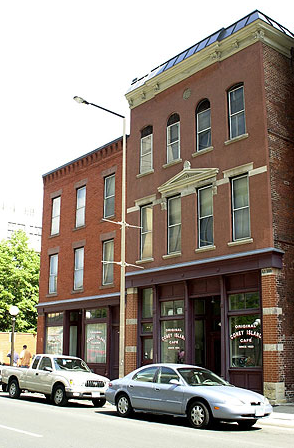Difference between revisions of "Coney Island Restaurant"
(table) |
m (Protected "Coney Island Restaurant" [edit=sysop:move=sysop]) |
||
| (2 intermediate revisions by one other user not shown) | |||
| Line 1: | Line 1: | ||
<div style="text-align: center;"> | <div style="text-align: center;"> | ||
| − | '''448 N. St. Peter Street, St. Paul''' | + | '''448 N. St. Peter Street, St. Paul (1923-1994)''' |
</div> | </div> | ||
| Line 12: | Line 12: | ||
| − | As its name implies, the restaurant served standard American fare—hotdogs, hamburgers, and the like—and it has for many decades. It was never owned by GLBT people (to the best of contemporary knowledge) , nor did it ever serve an explicit queer purpose. The Coney Island is instead a testament to earlier days, when unassuming (and likely unsuspecting) establishments became part of a secret queer world in the Pre-Stonewall era. | + | As its name implies, the restaurant served standard American fare—hotdogs, hamburgers, and the like—and it has for many decades. It was never owned by GLBT people (to the best of contemporary knowledge) , nor did it ever serve an explicit queer purpose. The Coney Island is instead a testament to earlier days, when unassuming (and likely unsuspecting) establishments became part of a secret queer world in the Pre-Stonewall era.<small>(1)</small> |
Minnesota’s cold climate prohibited a year-round outdoor cruising, and either major city did not have the population to support a sizeable gay underworld like those in Chicago, New York or Los Angeles. Instead, the Twin Cities queer populations met in “straight” places. | Minnesota’s cold climate prohibited a year-round outdoor cruising, and either major city did not have the population to support a sizeable gay underworld like those in Chicago, New York or Los Angeles. Instead, the Twin Cities queer populations met in “straight” places. | ||
| − | Outright communication or signs of interest received no less that expulsion from the establishment or, in severe cases, a visit to the Ramsey County workhouse. To avoid suspicion, queer people used codes, or secret body language and keywords that only those “in the know” understood. Codes were evident across the Nation, and varied regionally. | + | Outright communication or signs of interest received no less that expulsion from the establishment or, in severe cases, a visit to the Ramsey County workhouse.<small>(2)</small> To avoid suspicion, queer people used codes, or secret body language and keywords that only those “in the know” understood. Codes were evident across the Nation, and varied regionally.<small>(3)</small> |
| <div style="text-align: center;"> | | <div style="text-align: center;"> | ||
[[Image:Svc_coneyi.png]] | [[Image:Svc_coneyi.png]] | ||
| Line 24: | Line 24: | ||
|} | |} | ||
| − | In Minnesota, a surefire method of communication involved a pack of upturned Pall Mall cigarettes. If one man was interested in another, he placed the pack in the other’s eyesight. The object of desire, in turn, would either observe the gesture without a second thought, ignore it, or respond with verbal code. The infamous line is “are you a friend of Dorothy?” referring to the Wizard of Oz. Other phrases were likely uttered, yet these | + | In Minnesota, a surefire method of communication involved a pack of upturned Pall Mall cigarettes. If one man was interested in another, he placed the pack in the other’s eyesight. The object of desire, in turn, would either observe the gesture without a second thought, ignore it, or respond with verbal code. <small>(4)</small> The infamous line is “are you a friend of Dorothy?” referring to the Wizard of Oz. Other phrases were likely uttered, yet these died with the people who used them. |
| Line 30: | Line 30: | ||
| − | + | <small>(1)</small> Brown, Ricardo J. ''The Evening Crowd at Kirmser's: a gay Life in the 1940s" Minneapolis: The University of Minnesota Press, 2001. Pages 103-114. | |
| + | |||
| + | <small>(2)</small> Brown, pages 114 and 133. | ||
| + | |||
| + | <small>(3)</small> Vilanch, Bruce. "Notes from a Blonde: Breaking the Code" 'The Advocate.'' 10/13/1998. Page 73. | ||
| + | |||
| + | <small>(4)</small> Tretter, Jean-Nickolaus. Interview with the author, 3/22/2009 | ||
Part of [[Minneapolis/St. Paul, MN: 100 Queer Places in Minnesota History, (1860-1969), (1969-2010)]] | Part of [[Minneapolis/St. Paul, MN: 100 Queer Places in Minnesota History, (1860-1969), (1969-2010)]] | ||
Latest revision as of 11:26, 1 May 2010
448 N. St. Peter Street, St. Paul (1923-1994)
| A curious survivor of St. Paul’s obsessive (and often destructive) urban renewal projects, the Coney Island operates in two turn of-the-century structures that were once a mainstay of St. Paul’s urban landscape. The little buildings now hide in the shadows of looming neighbors.
|
The Coney Island's building is presently vacant. Image courtesy of Minnesota Public Radio. |
In Minnesota, a surefire method of communication involved a pack of upturned Pall Mall cigarettes. If one man was interested in another, he placed the pack in the other’s eyesight. The object of desire, in turn, would either observe the gesture without a second thought, ignore it, or respond with verbal code. (4) The infamous line is “are you a friend of Dorothy?” referring to the Wizard of Oz. Other phrases were likely uttered, yet these died with the people who used them.
(1) Brown, Ricardo J. The Evening Crowd at Kirmser's: a gay Life in the 1940s" Minneapolis: The University of Minnesota Press, 2001. Pages 103-114.
(2) Brown, pages 114 and 133.
(3) Vilanch, Bruce. "Notes from a Blonde: Breaking the Code" 'The Advocate. 10/13/1998. Page 73.
(4) Tretter, Jean-Nickolaus. Interview with the author, 3/22/2009
Part of Minneapolis/St. Paul, MN: 100 Queer Places in Minnesota History, (1860-1969), (1969-2010)
